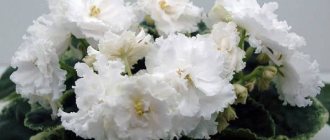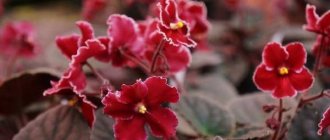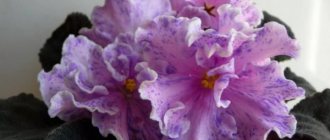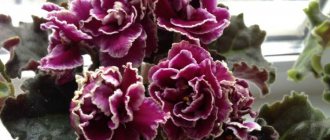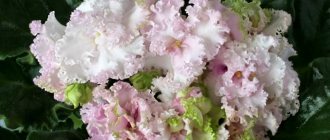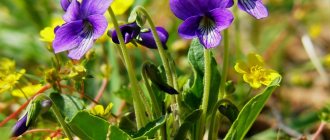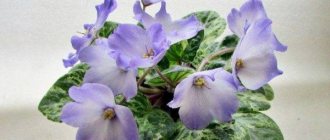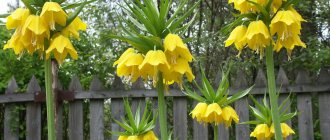Uzambara violets, which appeared in the collections of USSR flower growers just over fifty years ago, have changed dramatically during this time.
If our mothers and grandmothers rejoiced at the appearance of simple purple, pink or white flowers, today on the windowsills next to blooming pelargoniums and unique lithops flaunt luxurious fantasy violets of all shapes, sizes and shades. Sometimes, studying the modern names and photos of varieties of indoor violets, it is difficult to assume that these are direct descendants of the modest inhabitants of the South African mountain forests.
Violet African night
Large rosettes of the African Night violet are easily recognized among the many brightest and most unusual plants. The thing is that the breeder Konstantin managed to create a unique variety that amazes with giant velvety flowers, like the southern night sky, more like black stars on violets. The plant forms a neat standard rosette of simple dark green foliage with a noticeable purple tinge on the back.
Flowering is stable and very long. When grown, it does not cause any trouble to the grower; the variety does not require special care.
Growing conditions
In order for a violet to grow its rosette well and bloom for a long time, it must be provided with certain living conditions, without which it cannot do.
Priming
Specialized soil can be purchased at the appropriate stores, or you can make it yourself. To do this, take all the ingredients in equal parts:
- Deciduous ground.
- Peat.
- Humus.
- Sphagnum moss.
Everything is thoroughly mixed and large parts of the soil are removed if they cannot be crushed with your fingers.
The soil should be moderately loose and nutritious. Since if there is a lot of humus in it, the flower will increase the green part to the detriment of flowering.
Important! Self-prepared soil requires disinfection. It must be heated in the oven for 20 minutes at a temperature of 200 degrees. heat.
Pot
Some people prefer clay pots, others prefer plastic ones. But the main requirements for a pot are the following factors:
- For a child, the diameter of the pot is 6 cm;
- For an adult bush 8-12 cm - in larger pots the violet does not bloom until it grows the root system; this takes up to 2 years;
- The mandatory presence of drainage holes not only serves to drain excess water after watering, but also watering is carried out using the immersion method.
Important! The material from which the pot is made is chosen by the grower himself. Plastic ones are cheap and almost eternal ceramic ones are expensive and fragile. The main thing is the presence of the above factors in the pots.
Lighting
Violet does not tolerate direct sunlight from mid-May.
When the rays hit it, they completely burn the foliage and flowers.
Therefore, if the window is oriented to the south, you should hang a screen of white paper between the violet bushes and the window or move the pots to a room with a north orientation.
Temperature
The temperature where violets are grown should be in the range of 18-25 degrees Celsius. So, at low temperatures, all parts of the violet may rot, and at elevated temperatures, the leaves smolder from the heat.
Humidity
It is not recommended to spray violet bushes, since its fluffy velvet leaves do not dry well and then, after washing, unsightly stains form on them.
If the apartment is too dry in winter, then place a damp towel on the radiator and the water evaporates, increasing the air humidity.
Violet Ness Orange pekoe
Fans of variegated and unusual varieties will definitely pay attention to the Ness Orange pekoe violet, which generously bestows its owners with double or semi-double flowers of a luxurious salmon hue. Such corollas look especially impressive against the background of dark green leaf blades, edged with all tones of white and pink. The underside of the leaves has a pronounced red tint.
Caring for a plant at home
All Saintpaulias are quite demanding to care for . The shade of flowers and leaves, as well as the health of the bush and its appearance, depend on certain aspects.
Some factors in care directly depend on the method of watering.
Methods of caring for violets directly depend on watering.
| Watering method | Frequency | Fertilizers | Substrate |
| In a tray (a pot or pots are placed on a tray, water is poured into the tray) | Top up moisture levels as needed when soil dries out. On average it takes a week and a half. | Apply after about a week, every second watering. Fertilizer concentration is calculated based on half the dose recommended by the manufacturer. | The soil mixture can be bought at the store or mixed at home. The substrate consists of peat, deciduous soil, perlite and sphagnum moss, proportions approximately 3/3/3/2. |
| Under the leaves (water is poured onto the ground, without getting on the leaves and the growing point) | Watering is carried out as the substrate dries, the top should be dry. The frequency is approximately once a week, in winter and humid weather less often, and in heat and drought it may be necessary twice a week. | Fertilizing is carried out through watering. The amount of fertilizer should be half that recommended by the manufacturer. | The soil used is the same as in the first case. Sometimes, if necessary, the ratios are slightly changed, usually depending on the temperature and humidity of the content. |
| Wick (a wick is placed in the ground, which is brought out through the lower holes and lowered into a container under the flowerpot, from where the plant takes the required amount of moisture) | Water is constantly in the container and the flower takes as much as it needs, depending on the conditions. | There should always be fertilizer in the water. The fertilizer concentration should be 1/7 or 1/8 of the recommended amount. | For such watering it is better to use a special mixture, but sometimes the standard version is also used. A combination of peat and perlite in a 1/1 ratio is best; sometimes half of the sphagnum moss is added. |
Some maintenance conditions greatly affect the appearance of the plant, these include:
- Lighting and temperature. The light should be bright, but diffused:
- Direct sunlight burns the leaves;
And the lack of light deforms the rosette and changes the shade of flowers and leaves.
The temperature should be appropriate for the season:
- In summer 22-26°C;
- In winter 16-18°C.
- Dying parts– old leaves and faded flower stalks. As the leaves age, they die and need to be pruned, and after flowering, the flower stalks gradually fade and their appearance spoils the aesthetics of the bush;
Saintpaulias need to cut off the diseased parts.
Another important point of care can be considered planting and replanting rosettes. The first point for this procedure is choosing the size of the pot, it depends on the variety:
- Mini – up to 4-5 cm;
- Semi-mini – up to 6 cm;
- Standards – up to 10 cm;
- Large – up to 12-13 cm.
Next, the plant is removed from the pot:
- If it is mature, then the soil is shaken off and planted in a new one;
- And if it’s young, then they simply transfer it to a new flowerpot.
Important! With excessive light, the leaves become darker and the flowers change color. In bright light, the petals become darker and the fringe more green; if there is less light, the color becomes lighter, and the edging becomes lighter almost to white.
Violet Pink watercolor
The authorship of Konstantin Morev includes many interesting varieties, loved by many flower growers in Russia and neighboring countries . Violet Pink watercolor is rightfully one of the most popular. Large semi- or double white flowers have airy petals wavy along the edge with light, really pink watercolor strokes in the center. The edge of the petals is decorated with a white border. Violet leaf Pink watercolor, as in the photo, dark green with a white or cream border.
Care
In order for the Magenta variety to please with its long flowering, it needs to be properly organized:
- Watering;
- Timely transplantation;
- Feeding.
Watering
Water the Magenta violet with settled warm water by immersion. This method will ensure that the soil is completely saturated with moisture and does not flow down the edge of the pot.
Important! Excess moisture must be removed from the tray after 20 minutes. After watering.
Transfer
The variety is replanted annually at the beginning of spring, before the heat sets in, but the days are already long and filled with sunlight.
Recommendations for planting:
- Drainage in the form of expanded clay is poured into a selected pot in a layer of up to 3 cm;
- Place soil, filling the container to 1/3 of the volume;
- A violet bush is placed in the center, and the void around it is carefully filled with soil.
It is better to water the next day so that the wounds on the roots can heal, which can lead to rotting of the root system.
Fertilizer and feeding
For this purpose, purchase fertilizer that is specialized for “Uzambara violet” or “Saintpaulia”. Fertilizer application schedule is once every 2 weeks. In this case, it is necessary to dilute it, as indicated in the instructions on the package, without increasing the dose - this can burn the flower.
Important! Fertilizers are applied only to damp soil.
Violet Black Pearl
The spectacular violet Black Pearl, in the photo, was bred by E. Korshunova and received many flattering reviews both at Saintpaulia exhibitions and from ordinary lovers of these plants. The variety stands out both for the size of its large, densely double star-shaped flowers and for their rich velvety color, with tints of violet and purple shades. The rosette is formed of standard sizes, the foliage is dark green, oval, on long strong petioles.
When propagating the Black Pearl violet, flower growers sometimes encounter unusual mutations, sometimes leading to uniquely beautiful flowers, as in the photo.
Planting and propagation
Violets begin planting and propagating at the beginning of spring. You can propagate a flower:
- Dividing the bush.
- Leaf.
- Seeds.
Dividing the mother bush and propagation using leaves is quite often used by gardeners, as it does not cause any particular difficulties; you just need to follow the recommendations:
- The separated baby or leaf is planted in the center of a small pot (6 cm);
- Water a little (a tablespoon of warm water);
- Cover with glass, creating a mini-greenhouse.
Subsequent care will consist of ventilation and watering so that the soil does not dry out completely.
Seeds are propagated only by breeders to develop new varieties of violets.
Description and photos of popular varieties
Among the most popular varieties bred by Boris Mikhailovich and Tatyana Nikolaevna Makuni, one cannot help but highlight the following varieties:
- "Lel."
- "Blue Delight"
- "Pink Fairy Tale"
- "Your Majesty."
- "Garnet bracelet".
- "Running on the waves".
- "Mistress of Copper Mountain".
- "Vologda lace".
- "Pirate".
- "Tatyana's Day".
In their breeding work, several lines can be distinguished:
- Pink . It includes such varieties as: “Ah, Nastasya”, “Young Lady”, “Granddaughter”, “Sweetie”, “Larissa”, “Magic of Love”.
- Dark . Represented by burgundy and purple varieties: “Dark Prince”, “Mowgli”, “Panther”, “Magic”, “Mtsyri”.
- Lilac . This included varieties of blue and lilac shades: “Pirate”, “Ra”, “Blue Treasure”, “Lilac Excitement”.
- White . The most common varieties include: “Tatiana’s Day”, “Vologda Lace. “White-winged Gull”, “Snow Waltz”, “In Memory of Tanya Makuni”, “I Won’t Give It to Anyone”.
"Forest Magic"
The outlet is neat and small. The foliage is dark green. The leaves are round in shape, slightly jagged along the edges, slightly wavy. Peduncles are small and strong. The flowers are medium (about 4 cm in diameter), semi-double and double. The color of the petals is deep pink, almost raspberry, with a lush greenish fringe along the edge. Does not tolerate heat well.
When propagated by leaves, the variety requires attention: it is advisable to keep the cuttings in a greenhouse before rooting. But, in general, varietal characteristics are transmitted well.
We invite you to watch a video about violets of this variety:
"Your Majesty"
The variety is characterized by a large, neat rosette . The leaves are rich green in color, without a red tint on the underside. The leaves are round in shape, with a slightly pointed nose, wavy, slightly serrated along the edge.
The variety has large (up to 5 cm) densely double fringed flowers. The color of the petals is soft pink with a hint of lavender. The edges of the flowers are lighter than those in the center. If flowering occurs during the cool period, then the shade of the petals is less intense, pale pink. When it is completely cold, light greenery may appear on the petals.
The peduncles are strong, but do not collect flowers in a bouquet, but rather arrange them in a rosette, forming something similar to a wreath. Since a large number of buds are formed, these “wreaths” are superimposed on one another, resulting in a lush flower cap.
Flowers fully bloom quickly and last up to 6 weeks . The first flowering should not be expected earlier than a year after planting the plant with leaf cuttings. The first flowering does not have a large number of buds, but the second will be more abundant.
Among the nuances of cultivation, the following point can be highlighted: many breeders note that after several flowerings the decorativeness of the plant decreases, the flowers go from large double to the category of medium semi-double. To avoid this phenomenon, it is recommended to regularly rejuvenate the plant.
"Yoke"
The rosette is neat and compact, about 25 cm in diameter. The foliage is lush green . The leaves are round-oval, quilted, slightly wavy and jagged along the edge.
“Coquette” has large (5 cm) densely double flowers. The color of the petals is soft pink with a light green frill on the back side of the edge of the petal.
The variety produces flower stalks well. The flowers fully bloom gradually and very slowly. Blooms profusely and for a long time (up to 6 weeks). All this time, the blooming flowers retain their decorative properties and only just before they fall they darken and dry out. The violet will delight you with its first bloom in about fourteen months.
“Coquette” looks like another variety from the Makuni collection - “Your Majesty”. But the latter has a wider and looser rosette.
"Jupiter"
Nowadays this variety can be found less and less often in Saintpaulist collections, and the whole point is the capricious nature and increased sensitivity of the variety to growing conditions. It can also be found under the name “Lord”.
The socket is not the most compact and neat. Dark green small leaves sit on long petioles . It produces strong flower stalks, capable of holding such large inflorescences with a cap in the center of the rosette.
The flowers are simply huge (up to 8 cm), double, fringed. The color of the petals is dark pink, two-tone. Along the edge of the wavy petal there is a thin border a couple of shades darker than the main color. The petal itself is textured with light “marble” stains.
The variety is whimsical in cultivation. Not every gardener will be happy to “dance in circles” around this sissy. “Jupiter” does not tolerate drafts, insufficient and excessive lighting , and reacts very poorly to overfilling, as well as to underfilling. But, in fairness, it should be said that it is amenable to education. And those violet growers who do not give up seek “obedience” from this variety. But such beauty is worth the effort, because the variety is really good!
Variety resistance during breeding
Although not a chimera, which does not transmit varietal characteristics when propagated by most methods, this species successfully transmits all data. Each method is suitable for this variety, but some are difficult to carry out.
The most effective methods are all cutting methods . When propagated by seeds, the following often occurs:
- New varieties;
- Or sports subspecies.
Reviews
Lyudmila. “It’s a very beautiful rosette, but I mostly grow leaves. I saw the flowering cap only in other people's photos. I really dream of making mine bloom like that.”
Phobos violet attracts flower growers with its beauty.
Oksana. “I’ve read all the information about the variety and keep it with a tight rein. The lighting is strictly according to the norm, I lower the temperature a little, I specially keep several varieties separately in a cool place. The pot is quite small, relative to its size, only 8. It blooms with a beautiful head and produces many beautiful peas per petal.”
Marina. “I just can’t cope with Phobos, I’ve been dreaming about it for a long time, I want to collect a collection of cosmic varieties. She constantly lowers the sheets down or pulls them up, I just can’t find a good position for the light. Flowering is rare and not abundant, which is also a bit of a shame. But her color brightens up all the problems.”

